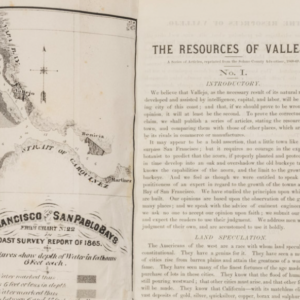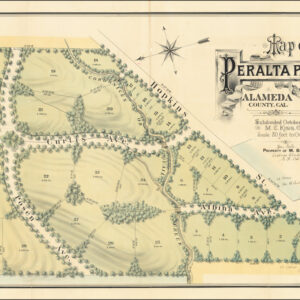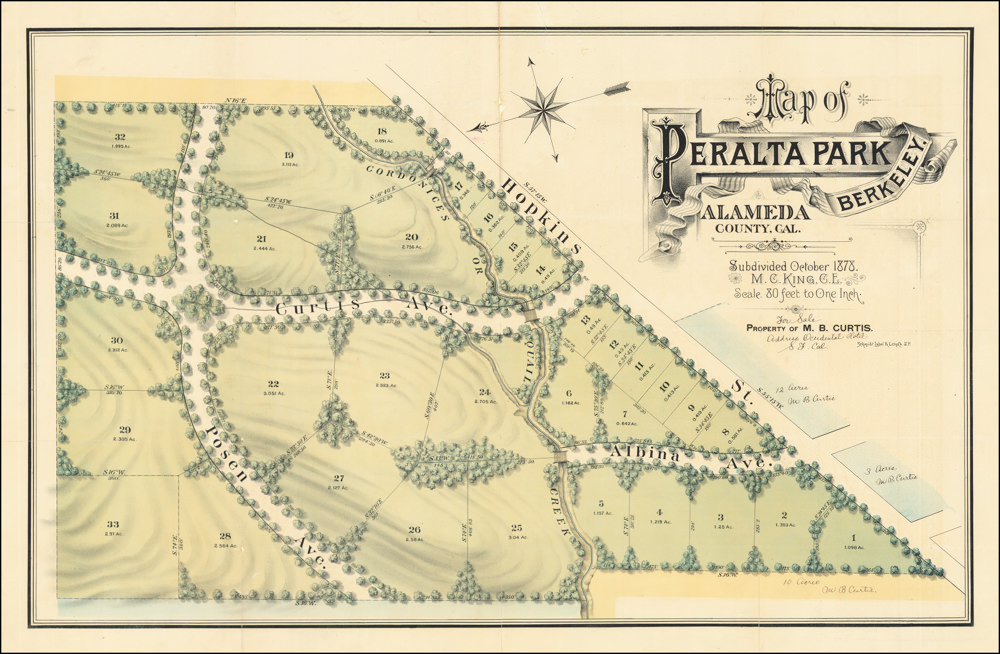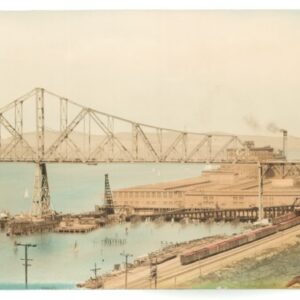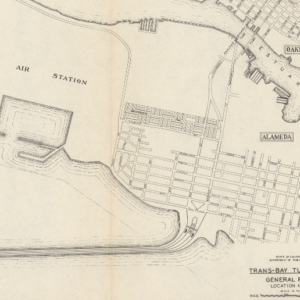Barlow’s rare and pioneering map of Benicia – the earliest comprehensive plan of one of California’s first state capitals.
Map of the City of Benicia Founded By Mariano G. Vallejo, Thomas O. Larking & Robert Semple 1847 Surveyed & Drawn By Benjamin Barlow City & County Surveyor.
$6,500
1 in stock
Description
In 1854, the newly built town of Sacramento was declared California’s state capital. It had grown at a break-neck pace, having been founded only six years earlier. Today, Sacramento’s status is not in doubt, but back in the early 1850s, discussions were still being held about where the new state’s capital would be most ideally placed. Another contender for the bid was Benicia on the Carquinez Strait, which like Sacramento, was a completely new town. Benicia was founded in 1846 when California still formally belonged to Mexico. After the annexation of California in 1848, the region was quickly incorporated into the Union as a state (September 9th, 1850). A capital was required, and for a time (1853-1854), that role was allocated to Benicia.
From this decisive era in California history, our excellent and early plan of Benicia derives. Among the many unknowns related to this map is the exact date of its publication. The map notes the year 1847 in its title, but this refers to the town’s official foundation and does not indicate the year it was published. The map was originally commissioned by the founders of Benicia, in particular Robert Semple, and was compiled from surveys done by Benjamin W. Barlow, the city & county surveyor of San Francisco. Our example is one of two nearly identical Benicia plans Barlow published in the 1850s. Ours is the rarer undated San Francisco issue; the other Barlow published in New York in 1851. The New York edition is held in more institutional collections than the San Francisco edition.
Renowned SF lithographers Britton & Rey the San Francisco edition of Barlow’s map, we believe, around 1852-53, although the exact date and chronology remain in question (pace Bancroft). Both editions are similar in that the layout has been superimposed on the natural topography, revealing that Benicia’s proposed waterfront relied on land reclamation along the coast. This ambition is evident in both Barlow maps. However, we are nevertheless convinced that the San Francisco edition postdates the New York edition for the simple reason that more land has been included for reclamation in this state. Specifically, we see how today’s South Street on the waterfront was designed by extending the land reclamation to include a small island off the coastline’s southern promontory. This expanded land reclamation suggests that the San Francisco edition is the later version and that its creation corresponds almost precisely to the period in which Benicia was being primed to be the state capital.
Other elements offer clues to date the map, for example the omission of a proposed railroad line for Benicia. In 1851, engaged citizens began planning a line connecting Benicia to Marysville on the Yuba River. Initial surveys were begun the following year, but the project was never developed due to interest shifting to the Transcontinental Railroad and the ultimate preference of Sacramento as state capital. The rapid development of this idea, and its equally rapid decline, meant that the planned railroad only figures in a handful of maps dating to the first half of the 1850s. One famous example is John R. Bartlett’s map compiled for the United States & Mexican Boundary Commission (1854). While this map primarily focused on showing the United States’ new borders following the Gadsden Purchase, it includes a demarcation of the proposed railroad. Similar echoes are found in George Baker’s Map of the Mining Region of California (1855), and Theodore Etting’s map of California printed in The Weekly Dispatch (1856).
We contend that the omission of this railroad on Barlow’s map is attributable to the fact that it was being prepared for publication as the railroad plans were first being put forward. While Barlow was prepared to make minor amendments to the outline of the town plan, he was not going to compromise the integrity of his plan for an idea that might never come to fruition. The choice appears to have been a wise one.
In sum, Barlow’s map constitutes one of the finest and most detailed plans of Benicia from the period immediately preceding its one-year service as state capital. As such, it is not just an essential document for collectors focussing on the Bay Area but should be considered a crucial fix-point in any collection dealing with the formative years of California.
A Short History of Benicia
Even though Benicia was founded at the relatively late date of 1846, its location on the Carquinez Strait was an ideal node for transhipping the produce of the interior to the bustling commercial port of San Francisco. During the earliest years of statehood, it had the advantage of being shielded behind the Bay and the US Navy presence in San Francisco in the unlikely scenario that Mexico would attempt to retake California.
The first Europeans to visit the Carquinez Strait were part of the expedition of Captain Pedro Fages and Father Juan Crespi. In 1772, they arrived on foot as part of the first reconnaissance of San Francisco Bay. From 1839, a series of giant land grants were bestowed around the northern Bay Area. Among them was the 13,000-acre Rancho Tolenas in the Suisun Valley, granted to Jose Francisco Armijo, and all of Mare Island, which in 1841 was allocated to Victor Castro. The largest of these land grants was nevertheless the 84,000-acre Rancho Suscol made to Mariano Guadalupe Vallejo in 1844. This enormous ranch encompassed all the lands currently comprising the cities of Vallejo and Benicia.
During the 1840s, growing numbers of American and European immigrants arrived in California, determined to settle alongside their Mexican counterparts. The growing number of what at the time essentially constituted foreigners increasingly caused tensions between the local Mexican populace and the new inhabitants. Eventually, the tensions erupted into open conflicts, such as the Bear Flag Revolt in 1845. This revolt began when the Kentucky dentist, Robert Baylor Semple, claimed a portion of the Suscol Ranch on the north shore of Carquinez Strait. His goal was to establish a new town.
By late 1846, Semple had legally acquired around half of the land he needed, and soon construction of the new town commenced. It was initially named Francisca, after Vallejo’s wife, but once Yerba Buena changed its name to San Francisco, it was decided that Benicia would be a more suitable designation. Even though Semple was the driving force behind Benicia, he received critical support from partners like William Colton (Mayor of Monterey) and Thomas O. Larkin (US Ambassador to the region). Jasper O’Farrell was hired to survey the lands and plot the new town. Work on its construction formally began in May of 1847, explaining why this is the date printed on the map. As evident from Barlow’s map, it was a goal from the beginning to include some of the tidal flats beyond the natural shoreline to create a waterfront city capable of handling maritime trade.
With the discovery of gold at Sutter’s Mill in 1848, the ensuing Gold Rush changed the dynamics for many places in Northern California. Benicia became one of the most important gateways for new prospectors to the gold-rich regions of the Sierras. The town also sported all of the amenities expected of a frontier city. Shops with supplies and goods, banks, hotels, saloons, and gambling halls were all to be found in abundance within the confines of Benicia. An important administrative leap came in 1850 when both Benicia and Monterey were formally incorporated into the new state of California – the first two towns to enjoy this honor. After that, the boom really took hold.
Benicia became an official Port of Entry and was quickly made the capital of the new Solano County. Private enterprise also boomed, especially in 1850 after The Pacific Steamship Company built a large commercial wharf with associated facilities like a coaling station, a repair, machine shop, warehouses, a blacksmith, and an iron foundry. Within a few years, the US Arsenal and Barracks were established, making Benicia one of the largest military arsenals in the country by 1852. The following year, Semple sold his holdings in Benicia to Thomas O. Larkin, who immediately started lobbying to make Benicia the new state capital instead of Sacramento. This was achieved in February of 1853, but the decision was soon rescinded, and the state legislature returned the prominent role to Sacramento. Despite being short-lived, Benicia’s status as state capital meant that it received significant investment and saw impressive growth throughout the 1850s.
Census
This example of Benjamin Barlow’s rare plan of Benicia in the San Francisco state has an impressive provenance: the Warren Heckrotte Collection. Before that, it was held in the Bancroft Library at UC Berkeley. Faded ink stamps from this institution can be found on the map’s verso and discreetly along the fringes of the map. A ‘withdrawn’ stamp in the upper margin of the recto confirms that this map was decommissioned legally.
The San Francisco edition of this map is scarce in institutional collections. A dedicated search in the OCLC reveals that several institutions hold the 1851 edition issued in New York (OCLC nos. 879769011; 18775793; 26023229), including Harvard, Berkeley, and the American Antiquarian Society. But the OCLC does not list any examples of the San Francisco edition of this map. We have nevertheless identified two examples: one at the Center for Sacramento History (call no. 1982/004/2183), and a second is part of the Honeyman map collection at the Bancroft Library (Bancroft Case C G9990.H6 no.7). We note that the Bancroft Library dates their extant example of this map to 1850, rather than 1852 as we do, which we acknowledge as a possibility.
Cartographer(s):
Benjamin W. Barlow was the City and County Surveyor for San Francisco following California’s incorporation into the United States. He was active during the late 1840s and early 1850s, but other than his maps, little is known about him.
Britton & ReyBritton & Rey (1852 – 1906) was a lithographic printing firm based in San Francisco and founded by Joseph Britton and Jacques Joseph Rey in 1852. Especially during the second half of the 19th century, Britton and Rey became the leading lithography firm in San Francisco, and probably California. Among their many publications were birds-eye-views of Californian cities, depictions of the exquisite landscapes, stock certificates, and no least maps. While Rey was the primary artist, Britton worked not only as the main lithographer but was essentially also the man running the business. In addition to their own material, the firm reproduced the works of other American artists like Thomas Almond Ayres (1816 – 1858), George Holbrook Baker (1824 – 1906), Charles Christian Nahl (1818 – 1878), and Frederick August Wenderoth (1819 – 1884). Following Rey’s death in 1892 Britton passed the form on to Rey’s son, Valentine J. A. Rey, who ran it until the great earthquake and fire of 1906 destroyed most of the company’s assets.
Joseph Britton (1825 – July 18, 1901) was a lithographer and the co-founder of the prominent San Francisco lithography studio Britton and Rey. He was also a civic leader in San Francisco, serving on the Board of Supervisors and helping to draft a new city charter. In 1852, he became active in lithography and publishing, first under the name ‘Pollard and Britton,’ and then ‘Britton and Rey,’ a printing company founded with his friend and eventual brother-in-law Jacques Joseph Rey. Britton and Rey became the premier lithographic and engraving studio of the Gold Rush era, producing letter sheets, maps, and artistic prints.
Jacques Joseph Rey (1820 – 1892) was a French engraver and lithographer born in the Alsatian town of Bouxwiller. At the age of about 30, he emigrated to America, eventually settling in California. Here, he soon entered into a partnership with local entrepreneur and civic leader Joseph Britton. Three years later, Rey also married Britton’s sister, allowing his business partner and brother-in-law Britton to live in their house with them. Rey and Britton were not only an important part of the San Francisco printing and publishing scene but also owned a plumbing and gas-fitting firm. In the early years, both men would sometimes partner up with others on specific projects, but by the late 1860s, their partnership was more or less exclusive.
Condition Description
Ex Bancroft Library. Laid on linen. Minor chipping in margins and decorative border and a number of minor tears, entering the printed image at the sides and bottom of the map.
References
